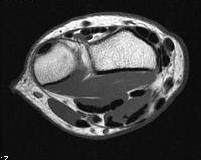Zones
I DIPJ
II Middle Phalanx
III PIPJ
IV Proximal Phalanx
V MCPJ
VI Metacarpal
VII Dorsal Wrist Retinaculum
VIII Distal Forearm
IX Mid & Proximal Forearm

Anatomy
Sagittal bands
- stabilise EDC
- extend MCPJ
Lateral bands
- lumbricals extended PIPJ
Zone 1 Mallet Finger
Clinical
- loss of extension of DIPJ
- +/- Swan neck deformity
- hyperextension of PIPJ due to unopposed central slip action
Issues
Avascular region of tendon at insertion into DIPJ
- explains poor surgical results
Mechanism
Closed
1. Forced flexion of extended digit
- Rupture of tendon
- Avulsion of tendon ± small fragment of bone
2. Forced hyperextension of DIPJ
- fracture of dorsal base of P3
Open
- Laceration over dorsum of DIPJ
Types
Type I
- closed trauma
- no bone or < 1/3
Type II
- laceration
Type III
- deep abrasion
Type IV
A) Transepiphyseal plate fracture in children
B) > 1/3 of joint surface
C) > 1/3 + Volar Subluxation of P3
Management
1. No or small Bony Lesion
Extension splint (Stack splint) for 6 to 8 weeks
- night splinting further 6 weeks
- 80% good results if treated early
- direct repair should be avoided (poor blood)
2. Bony lesion > 50% with volar subluxation
A. Extension splint
B. ORIF
- poor skin, high risk of breakdown
C. Dorsal blocking K wire / second K wire across joint
3. Chronic Mallet Finger
1. Arthrodesis
- joint incongruent, arthritic or fixed
2. Reconstruction possible if supple
4. Open
Suture skin and tendon together
Zone 3 Boutonniere Lesion
Definition
- disruption of central slip at PIPJ
Mechanism
Closed
- forced flexion of PIPJ
- causes avulsion of central slip ± bony fragment
Open
- laceration over central slip
- similar progressive deformity
Pathology
Deformity usually not present at time of injury
- develops after 2-3/52
1. Flexion of PIPJ
- due to loss of central slip
- unopposed action of FDS
2. Stretching of expansion between central & lateral slips
- transverse retinacular / triangular ligaments
3. Lateral bands migrate volar
- position volar to axis of rotation
4. Pull of lateral bands exclusively directed to DIPJ
- DIPJ hyperextends
5. MCPJ also hyperextends because of pull of long extensor
Examination
1. Hold wrist and MCPJ fully flexed
- relaxes lateral bands
- unable to actively extend PIPJ
2. Elson's test
- flex PIPJ to 90o over edge of table
- unable to actively extend PIPJ against resistance, will hyperextend DIPJ
Management
Closed
1. Splint PIP in Extension 4/52
- Leave DIPJ free and allow ROM
2. Capener Splint 4/52
Open
- central slip & lateral bands sutured with 5/0 nylon
- ff close to insertion, pull-out suture used
- PIPJ splinted in full extension for 6/52
- replaced with Capener splint when wound healed & sutures removed
Reconstruction
Palmaris longus weave
Extensor Tendon Repairs Zone 5 - 9
Prognosis
Excellent results of repair 5 proximal zones
Only 50% excellent results 4 distal zones
Surgery
Lacerations >50% zones V-VIII should be repaired
- modified Bunnell or Kessler best
- try to maintain length
Dynamic splinting
Greatly improves results and is key
- need 5mm excursion to prevent adhesions for flexors (Unknown for extensors)
- typical repairs shorten tendon
Outrigger with passive extension by rubber bands
- WJ 30o extension, MP's 10-15o flexion, IP's 0o
- allow 5mm excursion of tendon
